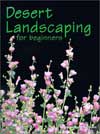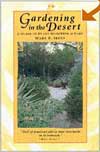A list of general xeriscape maintenance guidelines.

First Growing Season:
- All plants, even xeric varieties, require regular irrigation/rain during the first year to establish their roots.
- First year plantings also need monthly irrigation over the winter and spring (when the soil isn’t frozen).
- Fertilizing isn’t necessary when the soil is prepared properly at planting time.
Irrigation:
- When winter snow/spring rains leave the soil with good deep moisture, established xeriscapes need little if any additional water until summer.
- After a dry winter irrigate deeply every 2 or 3 weeks from early spring through May. In many parts of the country regular summer rains supply sufficient moisture. If rain is lacking, a good soaking every week or two will be enough.
Trimming and Pruning:
- Wait until early to mid-spring of the following year before trimming back perennials.
- Salvia, Agastache, Zauschneria and other species are cold hardier when left standing over the winter.
- Ornamental grasses and Sedum contribute winter interest and should remain uncut until spring.
- In cold climates, trim Lavender back lightly in mid-spring to remove the twig-tips with burnt, winter damaged foliage.
- Summer blooming shrubs like Blue Mist Spirea, Butterfly Bush and Potentilla can be cut back by 1/3 every two years to re-invigorate the plant and increase flowering.
- Most other shrubs need only occasional pruning to shape and thin crisscrossed interior branches.
- Don’t hack shrubs into a box or circular shape. It ruins the character of the plant and creates a lot of extra work.
Fertilizing and Mulching:
Most xeric native and adapted plants don’t need much fertilization. October is an ideal time to fertilize. Apply organic fertilizers or high quality compost when the fall root growth cycle is in full swing. Spot fertilize during the growing season as needed. All mulches, even gravel, need to be replenished annually to bring them back to a sufficient depth. Mulch materials should be checked in late spring and fall. Add more as needed to maintain a depth of 1-2 inches.
Provide a composting area and encourage its use.
Yard waste can be recycled into high-quality compost. This minimizes the load on landfills and encourages wise resource use.
Choose a well-drained corner of the yard that is convenient to the kitchen and out of sight.
Clear the area to expose the soil.
Compost bins are easy to build. Remember:
-
1) Use inexpensive materials.
2) Allow for air circulation and
3) Make the bin wide enough to turn and lift compost.
You can use chicken wire, woven wire, or inexpensive fencing to build a bin. Try using wood stakes, wire, or chain snaps to support and fasten the bin. Discarded wood pallets can be put together with wire to make an inexpensive rectangular bin. A portable bin can be built of wood slats and wire mesh. Cinder blocks or brick can be used if gaps are left to allow air circulation.
Commercially prefabricated composters are available.
Mow correctly.
Mow the grass when it is about 1/3 higher than the desired height.
Clippings can be left where they fall, recycling nutrients into the soil.
If clippings are collected, compost them with raked leaves and organic kitchen waste.
Never mow lawns too short. (Proper mowing heights can help lawns use less water. Grass cut too short is stressed and dries out quickly.)
Recommended Mowing Heights:
-
Bermuda 1 1/2 to 2 1/2 inches
St. Augustine 2 to 3 inches
Buffalo Grass 3 to 4 inches
Zoysia 2 inches
Fertilize wisely.
Many native plants do not need fertilizer since they are adapted to natural soil conditions.
Other plants, such as non-native grasses, need additional nutrients for healthy growth.
Use recycled lawn clippings, compost, or slow-release encapsulated nitrogen on lawns.
Use least-toxic methods of insect and disease control.
Such techniques, otherwise known as Integrated Pest Management (IPM),
take advantage of natural methods of control. This protects soil from
contamination, inhabitants wildlife from harm, and waterways from being
polluted with non-point source pollution.
Old-fashioned methods such as installing a birdhouse for Purple Martins can help encourage natural insect control.
Chemical controls will destroy beneficial insects as well as harmful ones.
Organic pest control such as insecticidal soaps and manual methods such as pulling weeds or using sand barriers may do the job.
Beneficial insects such as ladybugs and beetles should be encouraged and can even be introduced into a landscape.
Overwatering and nighttime watering may actually cause some diseases such as brown patch on St. Augustine lawns.
Difficult problems such as fire ants can be tackled with boiling water treatments and growth regulators containing fenoxycarb.





